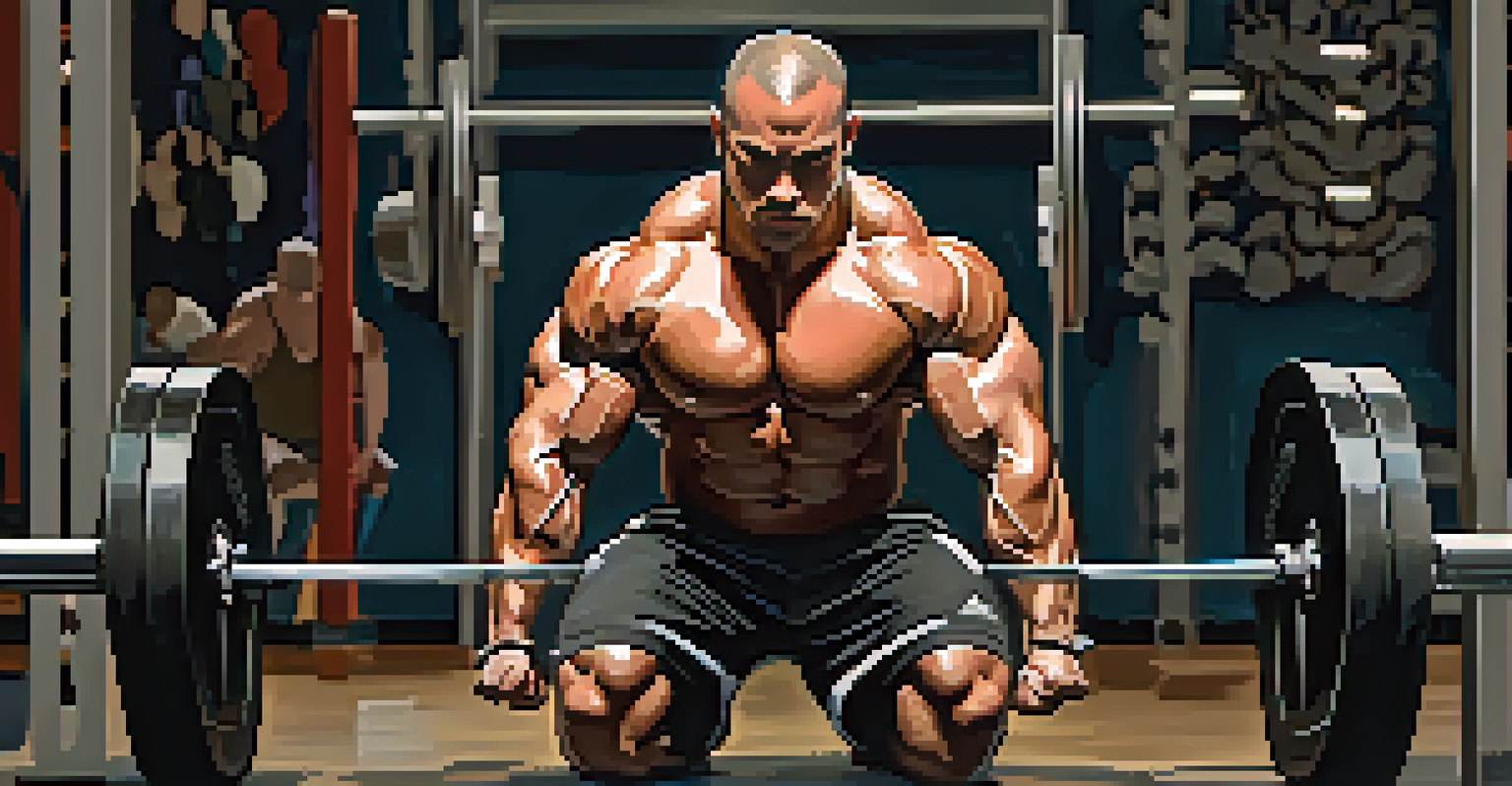The Science Behind Flexibility and Powerlifting Performance

What is Flexibility and Why Does it Matter?
Flexibility refers to the range of motion in your joints and muscles. It's crucial for athletes, including powerlifters, as it allows for better movement efficiency and reduces the risk of injury. Imagine trying to fit a square peg in a round hole; if your body isn't flexible enough, you won't achieve optimal positions during lifts.
Flexibility is the key to stability.
In powerlifting, flexibility can enhance performance by allowing lifters to achieve deeper and more stable positions, especially in the squat and bench press. For example, a lifter with good shoulder flexibility can position the barbell more effectively, leading to a more powerful lift. Therefore, understanding the role of flexibility is key for any serious powerlifter.
However, it's important to note that flexibility isn't just about stretching; it involves the nervous system and muscle coordination. This means that a comprehensive approach, including dynamic warm-ups and targeted stretching, is necessary to improve flexibility effectively.
The Relationship Between Flexibility and Strength
At first glance, flexibility and strength might seem like opposing forces, but they're actually interconnected. When a muscle is flexible, it can contract more efficiently, allowing you to generate more strength during lifts. Think of it as a rubber band; the more it can stretch, the more power it can unleash when snapped back.

In powerlifting, this relationship becomes evident during the squat. A lifter with good hip flexibility can achieve a deeper squat, engaging more muscle fibers and ultimately lifting heavier weights. This synergy between flexibility and strength is what many athletes aim to master to enhance their performance.
Flexibility Enhances Performance
Improved flexibility allows powerlifters to achieve better movement efficiency and optimal lifting positions.
Moreover, improving flexibility can help prevent injuries that often arise from tight muscles and joints, ensuring that lifters can train consistently and effectively. So, by embracing flexibility training, powerlifters can experience not just improved performance, but also a longer, healthier lifting career.
Types of Flexibility and Their Benefits
Flexibility can be categorized into static, dynamic, and functional. Static flexibility involves holding a stretch for a prolonged period, while dynamic flexibility incorporates movement and is crucial for warming up before lifts. Functional flexibility, on the other hand, combines strength and flexibility to perform specific movements effectively, which is particularly relevant for powerlifting.
Strength does not come from physical capacity. It comes from an indomitable will.
Each type of flexibility brings different benefits. For instance, dynamic stretching before a workout can enhance blood flow and prepare your muscles for the upcoming stress of lifting. Conversely, static stretching post-workout can aid in recovery and reduce muscle soreness.
Understanding these different types can help powerlifters design a training routine that maximizes their flexibility and overall performance. By incorporating a mix of these flexibility techniques, lifters can ensure they are well-rounded and prepared for the challenges of powerlifting.
Injury Prevention Through Flexibility Training
One of the most significant benefits of improved flexibility is injury prevention. Tight muscles and restricted joints can lead to compensatory movements that put unnecessary stress on the body. For powerlifters, this can mean the difference between a successful lift and a painful injury.
For example, a powerlifter with tight hamstrings may struggle to maintain proper form during the deadlift, increasing the risk of strains or tears. By incorporating regular flexibility training, lifters can enhance their range of motion and ensure that their muscles are prepared for the demands of heavy lifting.
Flexibility Prevents Injuries
Regular flexibility training helps avoid tight muscles and restricted joints, reducing the risk of injuries during lifts.
Additionally, flexibility can contribute to quicker recovery times. When muscles are flexible, they can recover more efficiently after intense workouts, allowing lifters to train harder and more frequently, which is key for building strength and muscle.
The Role of Warm-Up and Cool-Down Routines
Warm-up routines are essential for preparing your body before powerlifting sessions, and flexibility exercises should be a core component. A well-structured warm-up increases blood flow to the muscles and enhances flexibility, setting the stage for optimal performance. Think of it as getting your engine running before hitting the road.
Incorporating dynamic stretches, such as leg swings and arm circles, can help activate the muscles you'll be using during your lifts. On the flip side, a cool-down routine, which often includes static stretching, helps your body transition back to a resting state and aids in recovery.
By prioritizing both warm-up and cool-down routines, powerlifters can not only improve their performance but also cultivate a habit of self-care that promotes long-term health and success in the sport.
Flexibility Exercises Ideal for Powerlifters
There are several flexibility exercises that powerlifters can incorporate into their training. Some effective options include hip openers, chest stretches, and ankle mobility drills. These exercises target specific areas that often become tight due to the nature of powerlifting.
For instance, hip openers can enhance squat depth and stability, while chest stretches can improve bench press performance by allowing for better shoulder positioning. A simple routine combining these exercises can make a significant impact on a lifter's overall flexibility.
Warm-Up and Cool-Down Importance
Incorporating flexibility exercises in warm-up and cool-down routines promotes better performance and quicker recovery.
Moreover, dedicating just a few minutes after each training session to these exercises can lead to gradual improvements over time. Consistency is key, and even small efforts can lead to significant gains in flexibility and performance.
Conclusion: Embrace Flexibility for Powerlifting Success
In conclusion, flexibility is not just an afterthought in powerlifting; it's a crucial element that can enhance performance and prevent injuries. By understanding its importance and incorporating flexibility training into your routine, you set yourself up for greater success in the sport.
As you focus on building strength, don't forget to prioritize flexibility as well. The interplay between these two aspects can unlock new levels of performance and help you achieve your lifting goals more effectively.

So, whether you're a seasoned lifter or just starting, embrace flexibility as part of your powerlifting journey. You'll find that it not only benefits your lifts but also enriches your overall training experience.